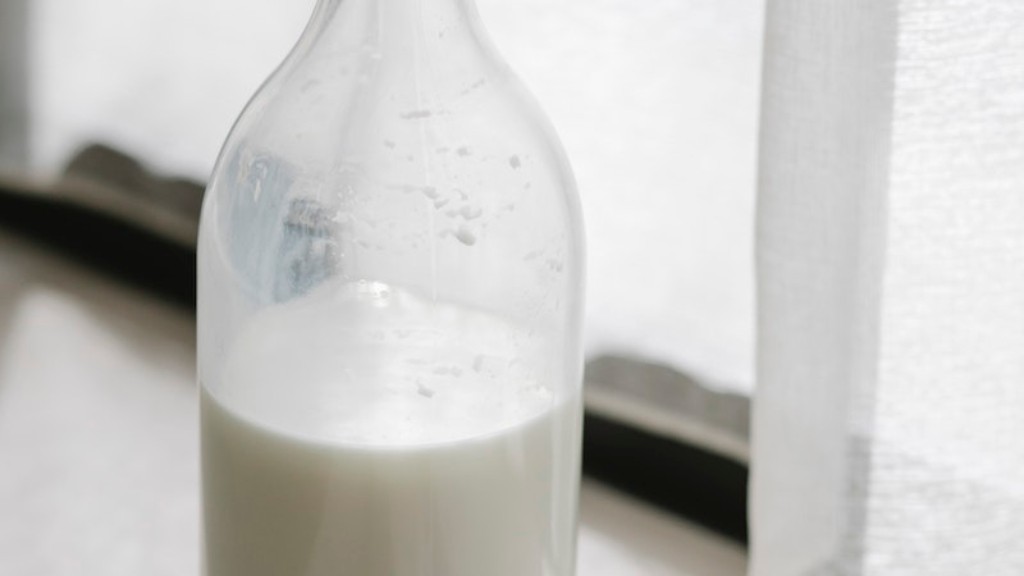Chemistry of Cheese Production
Milk is the fundamental building block of cheese production, and the chemistry of the cheese-making process begins when milk is transformed into curd. The chemical transformation of milk, or lactose, into cheese, requires a change in pH level and the presence of enzymes like rennet and starter cultures. The first step in cheese formation is the acidification of the milk, which is accomplished by adding starter culture bacteria that produces lactic acid. This lactic acid lowers the milk’s pH and begins the separation of the milk’s components, milk fat and milk solids. The milk solids, then, curdle and Gelatinize. Rennet, an enzyme from the fourth stomach of a calf, is added to speed up the process and helps to form the curd into a solid mass.
The process of cheese-making didn’t happen overnight, and its techniques were handed down through generations and modified depending on what was available for milk, cultures, and rennet in a certain region. Cheese-making techniques have been adapted and innovated, making it possible for development of different varieties of cheeses, like cheddar, Gouda, blue or Camembert.
The Origins of Cheese
Cheese as we know it today goes way back to the Neolithic era, about 7500 BC. An early form of cheese might have been made by accidentally curdling milk with an enzyme coming from a irritated stomach, bypassing the need of adding rennet intentionally.
Nomadic people in regions with large herds of goats, sheep and cows, discovered that cheese could be made by pressing and salting the curd, leading to longer shelf life and greater food supplies during the more difficult times of the year. Cheese was a way of preserving milk and also a sign of wealth and abundance.
Types of Cheese
The type of cheese and the method of preparation of cheese vary all over the world, and are influenced by the production and availability of the different kinds of milk. From traditional classics to the more innovative, artisanal variety, the types of cheese can be identified by different features, like texture, strength, colour and complexity of flavour.
In some cases, cheese can be qualitative divided into three main categories, soft, semi-hard and hard, depending on their moisture content. Soft cheese contains more water whereas harder ones, like Parmigiano Reggiano, contain less.
Making Cheese at Home
Cheese-making is a craft that has been passed down from generation to generation, and it is becoming increasingly popular to recreate classic cheeses or to come up with a homemade signature flavor. There are many recipes and videos that share tips and secrets of making cheese at home.
The process of making cheese is not complex and the ingredients are simple. Milk, culture, rennet, calcium chloride, citric acid and salt are all of the basic ingredients that are needed.
The quantity of milk that is needed to make cheese depends on the type of cheese being made. For most, 1-2 gallons of milk are sufficient for making a pound of cheese. Different types of cheese require different levels of acidity, humidity and temperature, and in order to reach the exact requirements, different recipes and techniques have been developed over the years.
Ingredients and Tools
In order to make cheese, there are some ingredients and tools that are necessary. Milk – ideally raw, unpasteurized milk from a farm or other source – starter culture, rennet, calcium chloride, citric acid, herbs and spices. The necessary tools include cheese-making equipment such as thermometers, pH strips and slotted ladles. But, many of these items can be replaced with common kitchen items, such as cheese cloths for strainers, or sterile spoons for stirring.
Cheese Production Today
Today, cheesemaking is a culinary art form and production is now very organized. Although small-scale cheese production is growing in popularity, production is mainly centralized at dairy and cheese factories, where they use machinery and modern techniques to produce their product.
Cheese production today is largely automated, with much of the manual labor replaced by automated systems to ensure that each batch of cheese is consistent in flavor, texture, and size. Modern cheese-making processes also have the advantage of being more efficient and requiring fewer resources. With the help of machines, cheese production is now faster and can feed a lot more people with less time and resources.
Cheese Nutrients and Benefits
Cheese is highly nutritious and a good source of calcium, protein, phosphorus and vitamin B12. It also contains other beneficial nutrients such as zinc, magnesium, potassium and riboflavin. Cheese is low in carbohydrates and a great source of “good” fat.
Cheese has multiple health benefits. It is known to help strengthen bones, reduce the risk of heart disease, and provide protection against some types of cancer. Cheese is also known to improve digestion, regulate blood sugar levels, and help in weight loss.
Cheese Production and Animal Welfare
Animal welfare is an increasingly important aspect of cheese production, and animal welfare regulations have been established to ensure that animals used in production are treated humanely. The milk used to make cheese is typically produced using cows or goats that have been raised in humane conditions and are free from any form of confinement.
In addition, the European Union has established standards for animal welfare that all cheese producers must adhere to. These standards involve providing adequate space and food for animals, as well as ensuring that they are not subjected to any forms of inhumane treatment.
Environmental Impact of Cheese Production
The environmental impact of cheese production is an increasingly important topic. The production of cheese often requires large quantities of resources such as energy, water and feed. These resources contribute to the emissions of greenhouse gases, which have a negative impact on the environment. As a result, cheese producers are now looking into ways to reduce their carbon footprint through the use of sustainable practices.
Some of the practices being employed by cheese producers include reducing emissions from the production process, promoting more efficient energy usage, using alternative sources of power, and adopting water-saving practices. Cheese producers are also focusing on using sustainable packaging materials, such as cardboard and paper, in order to reduce their environmental footprint.
Organic Cheese Production
Organic cheese production has increased in popularity in recent years, as consumers become more conscious of their food choices. In organic cheese production, the milk is produced free of antibiotics and hormones, and the animals are raised without the use of pesticides and other chemicals. Organic cheeses are also produced without animal rennet, and are entirely vegetarian and cruelty-free.
Organic cheesemakers are also taking steps to ensure that their production process is as sustainable as possible, such as relying on renewable energy sources, using organic feed, and promoting sustainable farming practices. Organic cheese production is able to reduce the environmental impact of the cheese-making process, while also providing consumers with a healthier and more ethical product.
International Regulations for Cheese Production
The production of cheese is subject to tight regulations in Europe, and these regulations are also recognized in other parts of the world. These regulations are in place to ensure the safety and quality of the cheese and to protect consumers from health hazards. International regulations for cheese production involve measures such as ensuring the safety of the milk used in the production process, monitoring the operation and cleanliness of the cheese facility, and testing the cheese for contaminants.
In addition to international regulations, certain countries, such as France, have their own specific regulations for cheese production. These regulations include rules pertaining to the production process, the ingredients used in the cheese, and the labeling of the cheese.
Laboratory Testing for Cheese Production
Laboratory testing is an important part of cheese production, as it ensures that the cheese meets safety standards and regulations. Laboratory testing is used to analyze the safety and quality of the finished product, and it is performed both on the finish product and on finished cheese prior to release.
For cheese production, laboratory testing is often done to analyze the culture activity, fat and moisture content, pH, and the presence of any contaminants. In addition, laboratory testing can also be used to verify the authenticity and origin of the cheese, or to determine the shelf life of the cheese.



